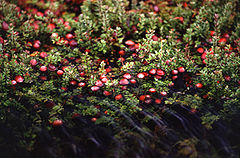
Back Fenberge ANG عنبية حادة الخباء Arabic عنبيه حادة الخباء ARZ Arándanu coloráu AST Mickekominan ATJ Mərcanı Azerbaijani مرجانی AZB Мүк еләге Bashkir Spongoulė BAT-SMG Журавіны Byelorussian
| Cranberries | |
|---|---|

| |
| Cranberry bush with fruit partially submerged | |
| Scientific classification | |
| Kingdom: | Plantae |
| Clade: | Tracheophytes |
| Clade: | Angiosperms |
| Clade: | Eudicots |
| Clade: | Asterids |
| Order: | Ericales |
| Family: | Ericaceae |
| Genus: | Vaccinium |
| Subgenus: | Vaccinium subg. Oxycoccus (Hill) A.Gray |
| Species | |
|
Vaccinium erythrocarpum | |



Cranberries are a group of evergreen dwarf shrubs or trailing vines in the subgenus Oxycoccus of the genus Vaccinium. In Britain, cranberry may refer to the native species Vaccinium oxycoccos,[1] while in North America, cranberry may refer to Vaccinium macrocarpon.[2] Vaccinium oxycoccos is cultivated in central and northern Europe, while Vaccinium macrocarpon is cultivated throughout the northern United States, Canada and Chile.[3] In some methods of classification, Oxycoccus is regarded as a genus in its own right.[4] Cranberries can be found in acidic bogs throughout the cooler regions of the Northern Hemisphere.
Cranberries are low, creeping shrubs or vines up to 2 meters (7 ft) long and 5 to 20 centimeters (2 to 8 in) in height;[5] they have slender, wiry stems that are not thickly woody and have small evergreen leaves. The flowers are dark pink, with very distinct reflexed petals, leaving the style and stamens fully exposed and pointing forward. They are pollinated by bees. The fruit is a berry that is larger than the leaves of the plant; it is initially light green, turning red when ripe.[6] It is edible, but with an acidic taste that usually overwhelms its sweetness.
In 2020, the United States, Canada, and Chile accounted for 97% of the world production of cranberries. Most cranberries are processed into products such as juice, sauce, jam, and sweetened dried cranberries, with the remainder sold fresh to consumers. Cranberry sauce is a traditional accompaniment to turkey at Christmas and Thanksgiving dinners in the United States and Canada, and at Christmas dinner in the United Kingdom.[7]
- ^ Cite error: The named reference
Stac10was invoked but never defined (see the help page). - ^ USDA, NRCS (n.d.). "Vaccinium macrocarpon". The PLANTS Database (plants.usda.gov). Greensboro, North Carolina: National Plant Data Team. Retrieved 11 November 2014.
- ^ "How Cranberries Grow: "Cranberries 101" – An Introduction". Cape Cod Cranberry Growers' Association. 2014. Retrieved 11 November 2014.
- ^ Steven Clemants. "Vaccinium oxycoccos: Small Cranberry, Technical Page". Brooklyn Botanic Garden. Archived from the original on 23 August 2011. Retrieved 26 March 2011.
- ^ "About Cranberries". Cranberry Institute. Archived from the original on 9 January 2010. Retrieved 13 November 2009.
- ^ Keith, Gabriel. "Cranberries: A colorful and nutritious fruit". South Dakota State University Extension. Retrieved 20 October 2023.
- ^ Carol Cloud Bailey (19 November 2009). "Garden Tips: Give thanks for cranberries, grown with a taste of Florida". TCPalm.com. Scripps Interactive Newspapers Group. Retrieved 20 November 2009.